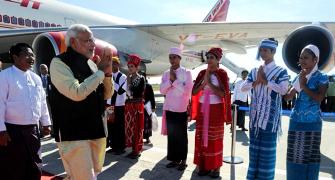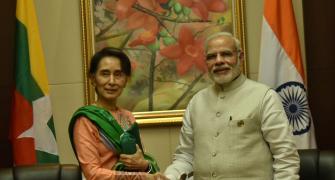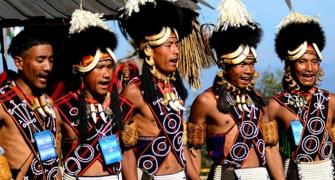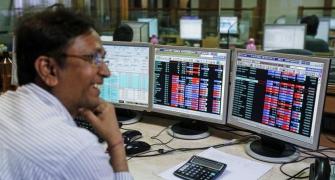'The real significance of the visit lies in the extent of the receptivity in Myanmar of the account of Chinese perfidy given by India's military and civilian top brass and how they assess the danger to themselves of dancing with the dragon,' notes Ambassador T P Sreenivasan.

The announcement that a high level hybrid delegation consisting of Chief of the Army Staff, General Manoj Mukund Naravane, PVSM, AVSM, SM, VSM, ADC, and Foreign Secretary Harsh Vardhan Shringla, would visit Myanmar on October 4-5, 2020 was a surprise.
Army chiefs and foreign secretaries visit Myanmar, but not together.
Apart from raising ticklish protocol problems, the visit might mark a paradigm shift, with implications for other countries.
I have heard many senior military officers expressing the view that in countries where the army calls the shots, like in Pakistan, we should encourage military to military talks on state matters not only to understand the minds of the real rulers, but also to influence them.
Civilian leaders come and go, but the policies do not change because the army is entrenched and unless the army changes its mind, progress is not possible.
But such an experiment of sending composite delegations of the top brass and the top bureaucracy does not seem to have been tried.
Even when Myanmar was a military dictatorship, it was the diplomats, who interacted with the rulers.
We have now acknowledged the power sharing arrangement in Myanmar by sending the COAS and Foreign Secretary together.

The timing of the visit was exceptionally significant as Myanmar, among our neighbours, has the closest of relations with China.
The Chinese influence has not dwindled even during Aung San Su Kyi's tenure since her compromise with the Myanmar army gave greater acceptability to the regime.
Even after the forthcoming elections, the same arrangements are expected to continue.
We cannot expect Myanmar to take sides with India, but our delegation may have gained some insights into China's policy during the visit.
We may also have had an opportunity to project the Quad as an inclusive arrangement for the Indo-Pacific rather than as an instrument for containing China.
A sanitised Quad may have some attraction to Myanmar down the line.
Our support to Myanmar on the Rohingya issue may cause concern in Bangladesh and among the human rights activists in the West who have chronicled the great human suffering and tragedy of the Rohingya.
No Islamic State seems to have championed their cause except as a humanitarian crisis.
Insurgencies within Myanmar have continued for years without the external world taking any notice of it.

India-Myanmar relations have come a long way since the days of General Ne Win and the rule of the junta, when we supported Su Kyi.
During my days as India's minister/charges d'affaires from 1983 to 1986, we had very little to do with the host government except on ceremonial occasions.
The only significant visit to India took place when General Ne Win visited India on a condolence visit some days after Shrimati Indira Gandhi's assassination.
Ne Win was very warm towards then prime minister Rajiv Gandhi and told him that, as an uncle, he was committed to expand bilateral relations.
But nothing changed in bilateral relations even after I flashed that statement far and wide.
We blocked Myanmar's re-entry to the Non-Aligned Movement at a meeting in Indonesia.
The only commercial deal was the import of some rice from them as a gesture of goodwill.
Heads of mission could meet the top brass only at the annual golf tournament hosted by Ne Win and even foreign office officials were accessible only on the golf courses!
The Indian embassy had plenty of time to have cultural activities which attracted the Indian community and designated local people.
We met at the British residence regularly to rehearse plays in which the local elite participated.
The local Indians carried out mostly illegal trade, which fuelled the economy.
As for projects, the foreign minister was supposed to have remarked that India was like NATO (No Action Talk Only).
Diplomatic, commercial, trade and military ties have increased, but the most significant change is the cooperation between the two countries in tackling insurgency on both sides.
Our repeated requests for joint action fell on deaf ears during my time.
But there is greater scope for cooperation in all areas if we can be even half as generous as the Chinese.
Nothing we can do will match the Chinese and all that we do will be seen as insignificant by Myanmar as well as the outside world.

A press release issued after the visit states: 'Both sides agreed to further strengthen their partnership in connectivity projects, capacity building, power and energy, deepen economic and trade ties, further facilitate people to people and cultural exchanges, and broad-base their defense exchanges across all the three services. It was also agreed to deepen cooperation to overcome the challenges posed by the COVID-19 pandemic.'
3,000 vials of Remdesivir were presented and sharing of vaccines was promised.
Among the many decisions taken relating to projects, it was agreed to work towards the operationalisation of Sittwe port in Rakhine state in the first quarter of 2021.
Further, 'the two sides discussed maintenance of security and stability in their border areas and reiterated their mutual commitment not to allow their respective territories to be used for activities inimical to each other.'
'In the last few years, both countries have made commendable strides in bilateral ties and explored new avenues of cooperation including fresh investments in oil and gas and power, infrastructure and pharmaceuticals,' it was stated.
If some of the projects mentioned materialise, India's involvement in Myanmar will deepen and our visibility will increase.
But none of these will worry the Chinese as it is the tradition for Myanmar to operate like a Chinese province.
As the press release concludes, 'the visit of COAS and FS to Myanmar reflects the high priority both countries attach to sustaining the momentum in their expanding bilateral ties.'
But the real significance of the visit lies in the extent of the receptivity in Myanmar of the account of Chinese perfidy given by the military and civilian top brass of India and how they assess the danger to themselves of dancing with the dragon.
T P Sreenivasan, (IFS 1967) has served as India's Minister/Charges d'affaires to Myanmar from 1983 to 1986.
Ambassador Sreenivasan is a frequent contributor to Rediff.com and his earlier columns can be read here.
Feature Presentation: Ashish Narsale/Rediff.com











